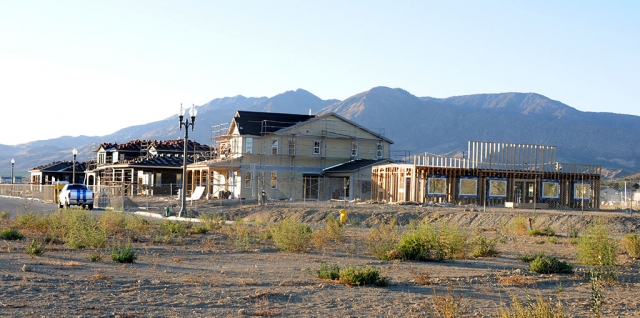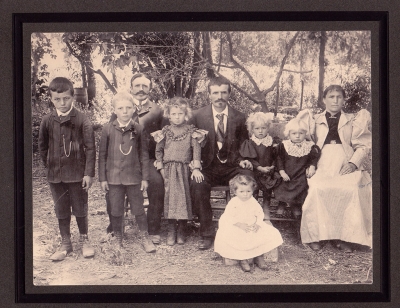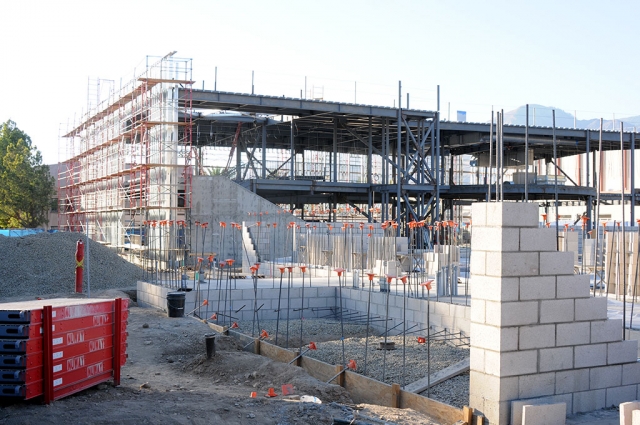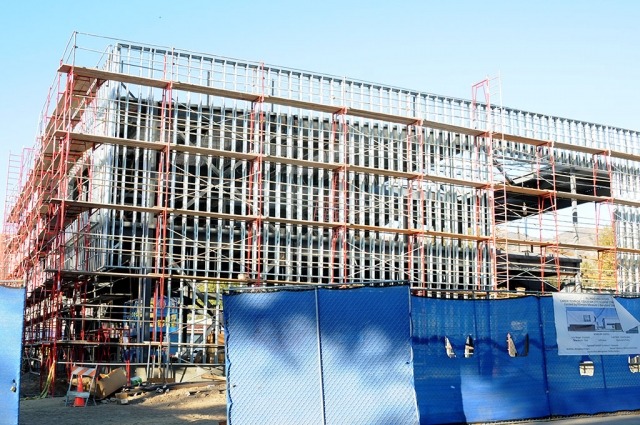|
By Anonymous — Wednesday, December 2nd, 2020
 With what seems like housing going up almost everywhere in Fillmore, the Heritage Grove Development has been making steady progress despite the COVID-19 pandemic. Heritage Grove Housing Development is located near the El Dorado Mobile Home Park. The development is broken into three sections: Iron Horse, East Bridge, and the Orchards, and has plans for a park as well. Enlarge Photo |
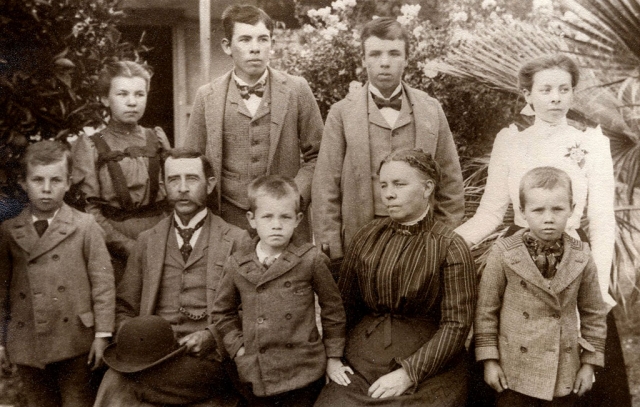 Pictured is the Arundell family circa 1910. Tommy Arundell put his first beehives in Pole Creek in 1879. Photos courtesy Fillmore Historical Museum. Enlarge Photo By Anonymous — Wednesday, December 2nd, 2020
Based on interviews by Charles Jarrett in 1934
Courtesy Fillmore Historical Museum In prior articles youâve read how families like the Peytons and Atmores came to our community, there are many other ways folks got here. Some came directly here because they already had friends or family, but many had more convoluted journeys. Carlo Basolo was born in Urgialo, Italy in 1860, one of six children. He worked digging tunnels in Italy, coming to the United States in 1889. His first stayed in Illinois working the coal mines. He and his two brothers, Dominic and Anton, brought their families to Bardsdale in 1898. George Henley, who in later years was involved in the Central Avenue shootout with Mason Bradford, was born in New Jersey in 1857 where his father worked in quarries. By 1880, George was working for railroads in Colorado. He then was involved in mining operations throughout the west. In 1886 he was in the Puget Sound area when his brother, Philip, told him of the brownstone deposits in Sespe. He had a successful mining operation until the introduction of Portland cement replaced much of the use of cut stone in building. He continued, however, to be involved in oil exploration, attempts to develop the Sespe as a recreational area and also in research into native languages for the fledgling Smithsonian Museum. Judge C. C. Elkins may have taken one of the most circuitous routes to Fillmore. He was born in Indiana in 1847, he was just 10 years old when he headed to Colorado (at that time part of Kansas) with a group of men looking for gold. Traveling by oxcart and side-wheeler river boat, they reached their destination, but like many others, found little gold. After another arduous trek, he returned to Indiana where he finished school, taught school, and married Annie Phillips. A few years later, the couple and two children again headed to Colorado. While Mrs. Elkins drove the wagon, he herded a hundred head of cattle. After a few years, he grew tired of cattle ranching and returned to Indiana. In 1884, he traveled to New Orleans for the World Cotton Centennial and spent some time traveling in the South, including Florida. While in Florida he bought 50 acres of orange groves near Orlando. A few years after returning to Indiana, the railroads began a price war. A round-trip ticket to Los Angeles could be had for $10, so the Elkins family came west once again. They original settled in Colton, but after a few years succumbed to Fillmoreâs allure where he opened a store and bought property. Does your family have a story about how they got to Fillmore? Let us know and weâll add it to our archives. |
|
By Ventura County Sheriff Department — Wednesday, November 25th, 2020
On November 19, 2020, detectives from the Simi Valley Police Department had a search warrant to obtain DNA from documented gang member Ricardo Magana reference an active investigation. Pursuant to the search warrant, the Ventura County Sheriffâs Gang Unit assisted the Simi Valley Police by locating Magana in the area of Telegraph Road at Willard Road in the city of Santa Paula. Magana was driving a vehicle at the time and a traffic stop was made. During the traffic stop, Magana displayed symptoms of being under the influence of a controlled substance and was arrested for several narcotic related charges. During a search of Maganaâs vehicle, a loaded Glock .45 caliber handgun was also located in the glove compartment. As result of the contact and arrest, Magana was booked into custody at the Ventura County Sheriffâs Main Jail facility for violation of PC 29800(a)(1) â Felon in Possession of a Firearm, PC 30305(a)(1) â Felon in Possession of Ammunition, PC 25400(a)(1) â Carry a Concealed Firearm in a vehicle, PC 23900- Remove, Alter, Obliterate a Serial Number, H&S 11550(e)-Under the Influence with a Firearm, H&S 11370.1- Possession of a Controlled Substance with a Firearm and H&S 11350(a)-Possession of a Controlled Substance. Magana is currently being held on $70,000 bail. Nature of Incident: Gang Member Arrested for Unlawful Possession of a Firearm Ventura County Crime Stoppers will pay up to $1,000 reward for information, which leads to the arrest and criminal complaint against the person(s) responsible for this crime. The caller may remain anonymous. The call is not recorded. Call Crime Stoppers at 800-222-TIPS (8477). |
|
By Anonymous — Wednesday, November 25th, 2020
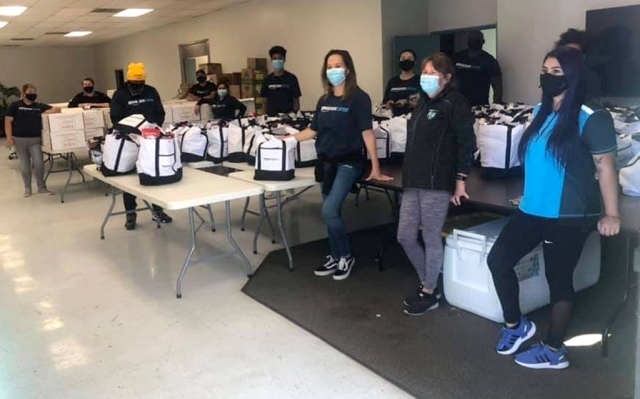 On Wednesday, November 18th from 1pm â 3pm at the Fillmore Active Adult Center Amazon.com partnered with the Santa Clara Valley Boys & Girls Club and the City of Fillmore in giving out free turkey dinners to families throughout the Fillmore community. Enlarge Photo |
|
By Anonymous — Wednesday, November 25th, 2020
|
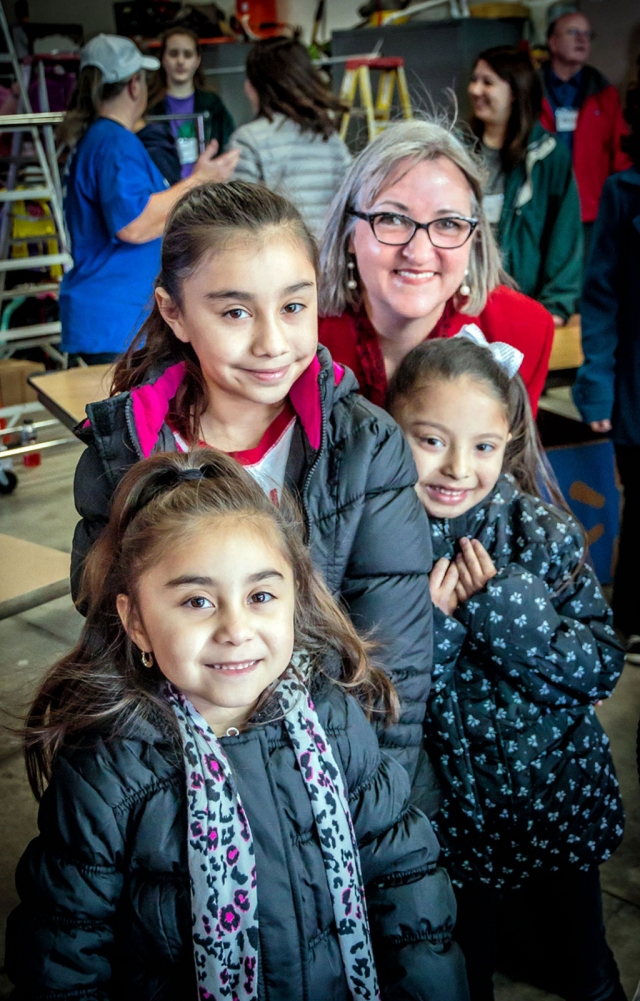 A photo from taken in 2018 of Laura Bartels with three young ladies wearing their new coats. Photo courtesy Bob Crum. Enlarge Photo By Anonymous — Wednesday, November 25th, 2020
Because of distancing the Santa Clara Valley Legal Aid is not able to give coats away this year, but keeping with the spirit of warmth, they will be giving a brand new fluffy blanket to every child who comes through the line December 12, 2020. Please consider keeping a family warm this year. Use this Go Fund Me Link to donate: https://www.gf.me/u/y9yp5c |
|
By Anonymous — Wednesday, November 25th, 2020
Non-essential businesses and personal gatherings are prohibited between 10 PM and 5 AM, November 21 at 10 PM to 5 am December 21.
Ventura, CA â The State has issued a limited Stay at Home Order generally requiring that non-essential work, movement and gatherings stop between 10 pm and 5 am in counties in the Purple Tier per the Stateâs Blueprint for a Safer Economy. The order will take effect at 10 p.m. Saturday, November 21 and remain in effect until 5 a.m., December 21, although it may be extended or revised as needed by the State. The Order does not prevent restaurants from operating after 10 p.m. for takeout and does not prevent community members from going to the grocery store or pharmacy for essential needs or walking their dog in their neighborhood. The Order does not prevent members of the same household from leaving their residences together, as long as they do not intermingle with others while out. This is not an exhaustive list, but we hope these examples will help clarify what residents and businesses may be permitted to do under the Stateâs Order. It does mean that we must restrict our interactions with people outside of our households for non-essential activities or social gatherings. Restaurant/Business Clarification: Sit down dining may only take place with members of the same household, it must be outdoors and must end by 10 pm. Restaurants can remain open for takeout or delivery past 10 pm. There is no required closure time. Grocery stores and pharmacies may stay open after 10 pm. All businesses not operating as part of Californiaâs Critical Infrastructure workforce must close by 10 pm. View the list of essential workforces from the State at: https://covid19.ca.gov/essential-workforce/. âWe ask our residents to continue to protect themselves, their loved ones, and their communities from COVID-19 by limiting gathering with anyone you donât live with, wearing a face covering whenever you leave home, maintaining at least 6 feet of distance from anyone you donât live with, wash your hands frequently,â said Rigoberto Vargas, Public Health Director. As a reminder, the County of Ventura is in the Stateâs Purple Tier: In alignment with Purple Tier 1, the following sectors are permitted for OUTDOOR operations only until further notice. These sectors must still maintain mitigation measures (social distancing, face covering, and sanitization): Cardrooms, satellite wagering Family Entertainment Centers (e.g. bowling alleys, miniature golf, batting cages, kart racing, and arcades) Gyms and Fitness Centers Movie theaters Museums, zoos, aquariums Places of worship Playgrounds and recreational facilities Restaurants Wineries Bars, pubs, brewpubs and breweries may operate outdoors if they are offering sit-down, outdoor meals. Outdoor operations may be conducted under a tent, canopy, or other shelter if no more than one side is closed. In alignment with Purple Tier 1, the following sectors are open for INDOOR operations. These sectors must still maintain mitigation measures (social distancing, face covering, and sanitization) and specific modifications in parenthesis below: All retail (maximum 25% capacity) Critical infrastructure Hair salons and barbershops Libraries (maximum 25% capacity) Nail salons and electrolysis operations Personal care services (e.g. body waxing, estheticians, tattoo, massage) Professional sports (without live audiences) Shopping centers (e.g. malls, destination centers, swap meets, excluding food courts and common areas) (maximum 25% capacity) To learn more about the Stateâs Tier system and specific allowable activities for Ventura County, visit the State of California's COVID-19 Blueprint for a Safer Economy website. |
|
By Anonymous — Wednesday, November 25th, 2020
Longtime Fillmore resident Josephine Myers will turn 100 years young December the 3rd. Josephine has lived in the area for some 90 years during which she and has seen many changes to our special town. Josephine or Jo as her many friends call her, was born in Nogales Arizona, December 3rd, 1920, to John L. and Gertrude Schleimer. Her father was an Arizona State Senator and dabbled in real estate, while her mother was a stay at home wife. An interesting fact, Josephine was the first cesarean birth in the state of Arizona. Shortly after Josephineâs birth, the family moved to Los Angeles, where her father continued in politics. In addition to being the Vice Counsel to Venezuela, he was also an oil broker. The family soon grew by two with the birth of sons, Jack and Jim. Her parents had many friends in the Ventra County area where the family would frequently visit. In the early 1920âs her father purchased a walnut orchard in lower Bardsdale, at the south east corner of Riverside Ave. and Sespe Street. This was Josephineâs first exposure to Fillmore. The family would often visit the ranch spending weekends and holidays there. Jo says she remembers her mother frequently hosting bridge games for her many friends in the county. There were always many visitors with lots kids to play with. One of her more vivid memories was coming up to the ranch shortly after the San Felicia Dam burst. The disaster which sent a massive wall of water sweeping through the Santa Clara Valley resulting in over 400 deaths. She remembers hearing neighbors saying that there were bodies caught in their walnut trees as well as trash, mattresses and furniture. Joâs brother Jim recalls hearing his mother say that they eventually recovered 14 bodies off their property. The disaster occurred on a Monday and she remembers going to the ranch that weekend, only to return to L.A. on Saturday morning. A sprinkler system was being installed in the yard and the water to the house was turned off. Her parents did not want to put up with the nuisance. She often wondered, if the water hadnât been turned off, would have the family returned home Sunday or Monday morning? In 1932, circumstances changed for the family, Josephine her mother and two brothers, Jack and Jim, moved to the ranch thus becoming fulltime Fillmore area residents. Shortly thereafter, their circumstances again changed, and they moved this time into town. For a short time, they lived in town on Sespe Street. They all soon realized that city life was not for them, they preferred country living, so it was back to Bardsdale. They moved into a house on Don Shawâs ranch where Josephine lived until she married. Joâs mother, Gertrude Schleimer, continued to live in the house until she passed away in 1965. When the family moved back to Bardsdale, Jo and her brothers started school at the Bardsdale Grammar School. Josephine often talks about living across the river, the experiences she had and the lifelong friends she made. She tells of them riding their horses to town on weekends, to go to the show. They would ride their horses across the river to town, where they would tie the horses to a tree behind Corioâs restaurant on the NW corner of Santa Clara St. and A St. The building is still there today. They would then walk uptown to the show. She said that sheâs seen a lot of changes in her 90 plus years here. The buildings along most of downtown, Central Ave., today looks very similar to what it did in the â30âs. The 1994 Northridge Earthquake did alter the landscape a little. She remembers all buildings having awnings that the merchants rolled in and out every day. It was a very friendly environment. Everybody knew the merchants and they knew you, or at least your family. As a kid, you didnât dare act up, because your parents would know about it before you got home. Everyone shopped right here in Fillmore, no one thought of going out of town to shop. Everything you needed was right here in Fillmore. On Central Ave. between Hwy. 126 and the High School, we had 5 full-service grocery stores. In North Fillmore we had 3 more grocery stores and on Main St. we had 2 or 3 small Mom and Pop grocery stores. We had 2 liquor stores and 2 theaters, we called them shows back then, 1 furniture store, 1 menâs and 3 womenâs clothing stores, a couple shoe stores, 4 car dealer ships, 2 drug stores, 4 service stations (I think 12 in all), a pool hall and a miniature golf course. At one point we even had an air strip across the river in the vicinity of the present-day horse stables. She recalls the Fillmore Festivals or May Day as it was called back then. Kids dancing around a May pole and feasting on pit B-B-Q prepared by one of the local service clubs. Playing bingo sitting on packing house field boxes, under the pepper trees along Sespe Street, feeling like a big winner if they won a 5-pound bag of sugar or some canned food. The men all grew beards, for this special event, so they didnât get thrown in the temporary jail and or get fined. It was a much simpler time back then. At Christmas time there were Christmas trees all lit up in front of the stores along Central Ave. A big tree in the middle of the intersection of Sespe and Central. The lighting of the 60-foot Redwood tree at the high school. Fillmore was one big family. During the war, the day of Pearl Harbor, Jo says that all their friends gathered at the service station at the SW corner of Santa Clara St. and Central Ave. to listen to the news. She remembers a potbelly stove a radio and 10 to 15 of her friends all listening intently. George Penrod a friend and longtime Fillmore businessman, ran the station. She also reminisces about the Potluck Club she and her friends started during the war. They would meet and share food once a week throughout the war. It was a close-knit support group as many of the husbands were off fighting. This group continued to meet, for some 63 years. At the end, grandchildren of the original 10 or 12 ladies were attending. Small town! Her graduating class at Bardsdale, all 6 of them, graduated together from Fillmore Jr. High and then in 1939 from Fillmore High School. Miss Bee Albright, long time high school teacher, was their 6th grade teacher. It was Beeâs first job teaching. The Jr High at that time was on the high school campus in the present-day Art building. Those lifelong friend were Joyce (Patterson) Vosler, Winston Haase, Tommy Harris, Jean Anderson and Virginia Korton. Shortly after graduating high school she married Aaron Myers, a native Fillmoreian. She recalls the night they got home from their honeymoon when their many family and friends showed up at their house to celebrate. The party was on, or rather a good old fashion âshivareeâ was on. They put Josephine in a wheelbarrow and paraded her and Aaron up and down Central Ave. They even went into the Fillmore Theater and as a movie was playing, they paraded them up onto the stage and introduced them as newlyweds. Then it was back to the wheelbarrow and up the street to Henrys Chili Hut for hamburgers. The night end with a party back at their new home. Got to love small towns. The marriage was a success, as they were married for 46 years until Aarons passing in 1985. They had one son, Don who now lives in Colorado with his wife Karen. After they married, they lived in a couple houses and in 1948 they purchased the only home Josephine has ever owned. The same house she now lives in and has for the past 72 years. Josephine began working once Don started school. She first worked with her mother in her catering business, as well as cooking for local service clubs. There are many ladyâs in Fillmore today that worked with Josephine and her mother, every Thursday, serving the Rotary Club at the Memorial building. She worked 18 years with her mother. She next worked 8 years for Orin Eberly in his Drug store next to the show. From 1973 to 1998 she worked at the cafeteria at San Cayetano Grammar school. She has said the reason she quit the cafeteria, at age 77, was that she realized she was then serving children of the children she first served when she started working there. It was time to retire. After several years spent as a widow, longtime friend and widower Dick Schmittou, a long-time teacher and rancher in Fillmore, came into her life. They, with their late spouses had been friends for many years. Dickâs wife Corinne graduated at Fillmore with Josephine in 1939. Their friendship grew into something special and they have been happily together for more than 25 years. They have enjoyed many vacations and trips together. Dick is affectionately referred to as âGrampa Dickâ by Joâs many grandchildren and great grandkids Over the years Josephine has been an avid traveler and ambassador for the City of Fillmore. At last count, sheâs been on 27 Tauck or Maupin tours and a number of cruises. Sheâs been on tours in all 50 states, 6 of the nine Canadian Providences, 7 European countries and has done 3 major trips in and around Mexico. As far as being an Ambassador for Fillmore, this is how the conversation usually goes when she meets someone on one of her many trips. âHello,â Iâm Josephine Myers from Fillmore Californiaâ. Naturally they will eventually ask, where is Fillmore? Shortly thereafter these people know everything there is to know about her special town of Fillmore. The family had a big party planned, but as fate would have it, Covid-19 has taken over our lives and any idea of a party is out. So, the family is asking that if those of you that know her (or if you do not know her, but appreciate her Fillmore Ambassador role) and would like in some way to help her celebrate, you might give her a call or better yet drop her a card or a note letting her know that you are thinking of her on this extra special birthday on December the 3rd. Her address is 239 Third St. Fillmore. |
 The Atmore home in Sespe purchased by Mathew Atmore. The Atmore family moved to the district in 1877. Photos courtesy Fillmore Historical Museum. Enlarge Photo By Anonymous — Wednesday, November 25th, 2020
Courtesy Fillmore Historical Museum Matthew Atmore as told to Charles Jarrett by his son, âBuckâ Atmore in 1934. Prior to coming to our area, Mathew Atmore had an eventful life. He was one of four brothers who came to Michigan from England at an early age, settling in Kalamazoo, Michigan. He was just 15 when gold was discovered in California, and then began a life that was to be filled with adventure for many years to come. Parties were being organized everywhere to come to go California to search for gold and as the boy watched his older brothers making ready for he trip he determined that he would not be left behind. Secretly making his plans, he was all ready to run away and join a party when his father heard of it, and after presenting him with a hundred dollars, told him to go ahead. Crossing the plains with a wagon train, they reached Placerville in 1852. For four years he probably had about the same fortune as did the majority of gold seekers in California at that time. Books say the yellow metal was plentiful, but actual fortunes founded in Placerville were hard to find. It is likely that his mining ventures were about on a par with those of most âForty-niners.â In 1856 he decided to leave California for good. He took a boat at San Francisco bound for Panama. Aboard the old sideâwheeler were all sorts of returning gold seekers. Some were penniless, some played cards for high stakes, and the ranged from the resplendent suave card sharps and swaggering road agents, to the men who had stakedeverything to search for gold and were now returning , disillusioned, empty handed and aloof in their own misery, Two years back in Michigan was enough for Mathew Atmore, and in 1858 he landed in Placerville the second time. He started freighting mining machinery from Sacramento to Virginia City, but the way of Lake Tahoe and the American river. Driving six head of oxen to a wagon, it took him seven days to do the trip one way. Hay was $80 a tonand sold in bundles tied with rawhide. He received 20 cents a pound for his hauling. Driving an ox team over mountain roads was probably noteworthy for itsthrills, but a greater opportunity for adventure was soon to present itself. In 1861 he was turning his tired animals into the corral at Sacramento when word reached him that they were organizing the Second California Cavalry, and the regiment was all set to head for the south where it would be given an opportunity to help keep the Rebels on the run. Mathew apparently didnât give the matter much consideration he simply locked the corral gate, sent word to one of his brothers he was going, and was gone. The Second California Volunteer Regiment of cavalry was soon to learn the fallacy of depending too much on army rumors. They werenât needed just then to keep the Rebs on the run, but there were a lot of Indians whowerepot shooting the immigrants out in Nevada and, would the Second Regiment do something about it before they headed for the main event that was taking place below the Mason-Dixon line? The Second Regiment would, and did, but that attended to, they had another chore to do before they could go see about the war between the North and the South. The government wanted a fort built at Salt Lake City. Forone whole winter the brave cavalry men turned lumberjacks and hauled logs down from the mountains to build Ford Douglas and still stands a few miles out of the city (https://en.wikipedia.org/wiki/Fort_Douglas). After that they did manage to get in on a real fight. Some 700 Indians from a dozen tribes had banded together and they moved west through southern Idaho. The Indians had gone into winter quarters and two companies of the Second Californians were sent out to return them to reservation. During the ensuring fight, Atmore was thrown from a horse onto the frozen ground and broke his hip. Nowadays when a person breaks a bone they wonât let him bat an eye till itâs set and healed, but he had to take a four-day ride to Salt Lake City before he could have it attended to.The injury left one leg considerably shorter that the other for which the government awarded him six dollars a month pension during the later years of his life. He was mustered out at Fort Douglas in 1864 and returned to Michigan where he married Mary Elizabeth Gorham two years later. While in Michigan, they had 4 children, Haydee, Grace, Fred (Buck), and Ruby who died in infancy. The Atmore family moved to this district in 1877, when Mathew Atmore purchased a relinquishment on a homestead located where the Calumet oil lease is now. Due to some error in the land titles he lost the ground he had located on, and a year or so later purchased a relinquishment on 80 acres of land located near the present Atmore place in Sespe. |
 Above are some of the toys that were collected from last yearâs Holiday Toy Drive with Santaâs helpers loading up the truck. Enlarge Photo By Anonymous — Wednesday, November 18th, 2020
The Fillmore Fire Department in conjunction with the Fillmore Fire Foundation is kicking off the annual Holiday Toy Drive this week. Collection drop off boxes for new toys are available at the Fillmore Police and Fire Stations. As part of the Toy Drive, on Sunday, December 6th, the Fire Department will be holding the annual Chicken Dinner Fundraiser to collect donations that are used to purchase hundreds of toys for children in the Fillmore/Piru area. A complete chicken dinner meal is prepared for anyone wanting to donate ten dollars ($10) that will be used to purchase a new toy. Because of necessary COVID-19 precautions, this year the dinner will be held at the Fillmore/Piru Veteranâs Memorial Building City, 511 Second St. Dinner will be served from 4:30 -7 PM. Again, due to COVID-19 restrictions, all meals will be for take-out only and will be available via a contactless drive-thru process. For this year only, we are requesting a monetary donation in lieu of a new toy to avoid less person to person contact. The hundreds of toys purchased from this event will be combined with those that are donated by the Community and then distributed the following week on Saturday, December 12, in a huge Community Holiday Giveaway event. The Holiday Giveaway event will also be a drive-thru and reservations are mandatory. To order your tickets for the December 6th BBQ Chicken Dinner call 805-524-1500 ext 226. To register for the Community Holiday Giveaway, go to recreation@fillmoreca.gov and leave a message. |

